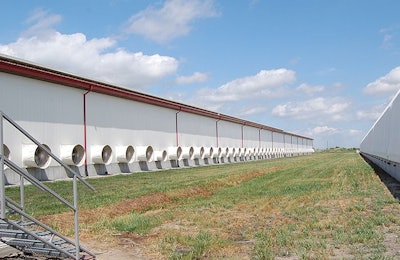
Proper ventilation in poultry houses is crucial to bird health and ultimately profitability for producers. Employees should understand the importance of the laying hen house ventilation system and be properly trained on how to identify issues.
The most important things for each employee to understand varies on their position, said Brett Ramirez, Ph.D., assistant professor in the Department of Agricultural and Biosystems Engineering at Iowa State University (ISU).

Iowa State University's Brett Ramirez offers insight to properly training employees in order to ensure ventilation systems are working to there full potential. (Courtesy Iowa State University)
“Daily caretakers need to spot abnormalities (ventilation related or not) and be able to properly communicate them to their supervisor," he said. "Managers need to know the general system operations and why, so that if something is reported or they notice something, they can begin troubleshooting and solving the problem. Upper management needs to be able to synthesize new technology, concepts, societal demands, etc. to see how ventilation can be a tool for improving productivity and profitability."
The first sign of a problem is if anything abnormal is happening.
“This is where training is key because the employees need to know what tools (even if it as simple as using their eyes) to use to recognize problems," he said. "Most systems hum along and blend into daily routines; problems arise when something deviates from this normal. There are also some problems that just exist in the system. These problems generally require measurements and some data to start to dive into if an issue exists. I would argue this is more optimization than problem solving.”

Individuals learn how to collect fan airflow data in an egg laying house during a training session. (Brett Ramirez)
“Practice doesn’t make perfect; it makes permanent,” he said.
He added that looking at ventilation training methods from other livestock industries may be beneficial.
“On (the) swine side, hands-on activities with a mobile ventilation trailer has had very good success -- something I have been considering for the egg industry," Ramirez said. "Engaging the employees in the things they need to do in a ‘mock’ atmosphere, accompanied by training has worked well."
He said he has heard of some farms that collect all the issues reported for a year, then go through a training session as an operation on each reported issue for employees to troubleshoot the problems that occurred.
What employees should be looking for regarding ventilation
Ramirez explained how he identifies problems within a barn by putting himself into the context of a particular barn and then by asking himself the following questions:
- What season is it?
- How old are the birds?
- What type of housing system is it?
- What is the stocking density?
- What is the health status?
Once Ramirez establishes the answers to his questions, he starts checking the birds for any abnormalities. Then he evaluates the room temperature.
“The spatial distribution of temperature and how the temperature behaves over time in the barn can say a lot about how the ventilation system is performing,” he said.
Then he analyzes what stage the ventilation system is in and how far open the inlets are.
“Temperature is by no means the silver bullet, but it can start the process and help direct future inquiries,” he said.
He suggested that employees use one of their passes through the house to only pay attention to ventilation equipment. This will help establish a baseline and keep it at the forefront.
“There is so much going on in a house and so many things do, ventilation tends to blend in and is only noticeable when there is a major problem,” he said.
Employees should be looking for issues that can be easily solved.
“Cleanliness, for example, can solve a lot of issues," he said. "Keep fans, shutters, light traps, inlets, heaters, etc. clean. This pays dividends in terms of efficiency and durability. Performing routine maintenance falls into this same category. Doing the little things adds up, (greasing bearings, tightening belts, etc.) because if this is neglected, equipment failures happen."
Training employees for ventilation during labor shortages
Labor shortages are an issue in all areas of the livestock industry, particularly for trained labor. Due to the skill level ventilation training takes, training employees is always tough, but especially when the available labor isn’t there.
“Historically, ventilation has always been a tough subject," he said. "It’s not intuitive and very different than traditional animal husbandry. It is also typically viewed as a necessary evil and not a tool. Ventilation (or environment) is truly like nutrition, management, genetics, etc. in that can be optimized/improved to increase productivity and profitability. I do think with the advancement in technology, there will be some great opportunities to improve employee ventilation training."
Ramirez and his co-workers at ISU are working to make sure employees have access to the training they need.

















